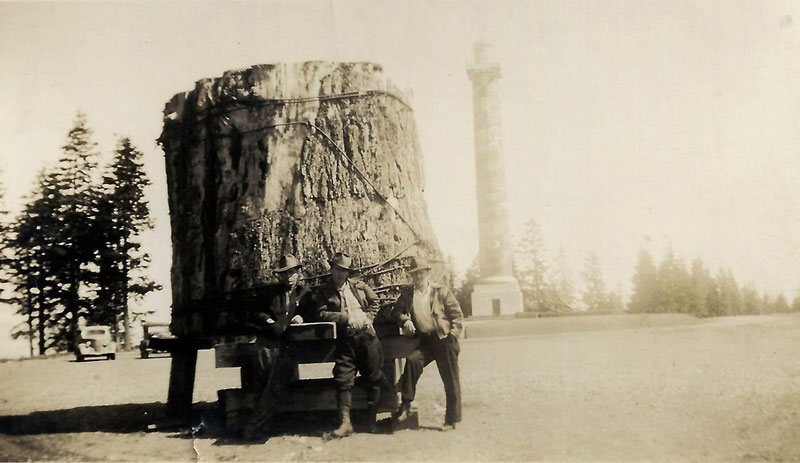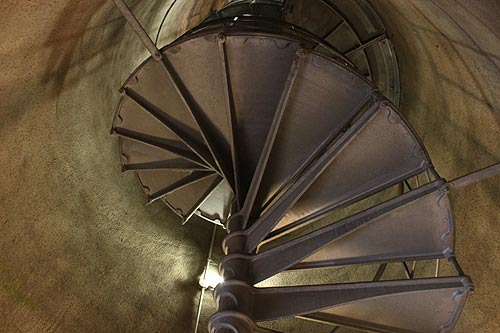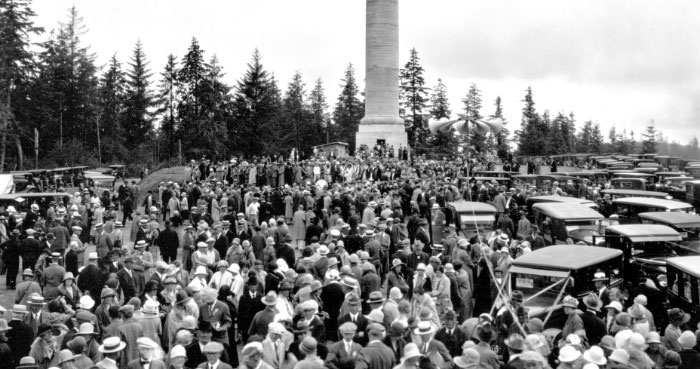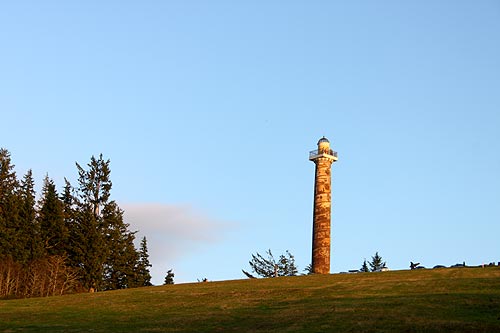Beginnings, Construction of the Astoria Column - N. Oregon Coast History
Published 08/19/21 at 7:05 PM PDT
By Oregon Coast Beach Connection staff

Includes exclusive listings; some specials in winter
In Cannon Beach:
Includes rentals not listed anywhere else
In Manzanita, Wheeler, Rockaway Beach:
Some specials for winter
In Pacific City, Oceanside:
Some specials for winter
In Lincoln City:
Some specials for winter
In Depoe Bay, Gleneden Beach:
Some specials for winter
In Newport:
Look for some specials
In Waldport
Some specials for winter
In Yachats, Florence
Some specials for winter
Southern Oregon Coast Hotels / Lodgings
Reedsport to Brookings, places to stay; winter deals
(Astoria, Oregon) – Soaring some 700 feet above the north Oregon coast town, the Astoria Column is one of the most recognizable features of the Pacific Northwest coastline. Sitting on 600-foot-high Coxcomb Hill, the column itself juts upwards another 125 feet, with 164 steps up to the top.
The Astoria Column officially opened on July 22, 1926, but it took almost 30 years from seed idea to dedication day.
The Oregon coast icon has always had lofty ambitions. Its painted exterior chronicles the history of the town – including Lewis & Clark's stay around here – but beyond that its beginnings were inspired by the Eiffel Tower in Paris. Indeed, city bigwigs over a century ago hoped to create something that would rival that immense wonder.
Astoria back in 1898 was a place full of wonders, at least to people at the time. Like the rest of the world, newfangled inventions were making life more interesting, convenient and at times certainly more dangerous. That eagerness for the future while still honoring the past was overflowing in Astorian's minds as its centennial was approaching. Locals here were hoping to whoop it right.
It was that year the idea of an Eiffel Tower-like structure on the Oregon coast came to be, but such progress moved slowly and well into the next century. In 1911, the town's centennial brought at least an electric sign to the top of the hill that read “1811 – 1911.”

Those 100-year celebrations provided plenty of fundraising for the city, and it wound up with lots of funds to further the idea, purchasing the land of Coxcomb Hill in 1914. Among the major donors was John Astor, a descendant of John Jacob Astor, for whom the town was named.
Meanwhile, locals had hoped a road would be built up there, but that didn't exactly happen until one town leader named Chitwood carved a pathway up by his own means.
That year meant a big celebration again in the new park, now named Astor Park. In 1917, Chitwood appeared on the scene again and helped create a massive flagpole atop the hill.
Between there and 1922, progress stalled. That year, a fire devastated downtown Astoria and all thoughts of any tower were tucked away, deemed too expensive in the midst of the civic rebuilding efforts.
In 1925, the concept was reinvigorated by Ralph Budd, president of the Great Northern Railway, who wanted to build numerous markers across the U.S. celebrating the pioneers of the West. Under his aegis, the project moved rather quickly. It was he who talked to New York architect Electus Litchfield, and in turn they got together with artist Attilio Pusterla about his sgraffito painting technique for creating the history mural. Initially, they wanted to create only a massive flagpole in that spot, but the idea soon became a structure that featured the events in Astoria from the Corps of Discovery to the building of the railroads here.
In December of ‘25, Budd made the announcement of the monument on Coxcomb Hill itself. Once again, the Astor family of New York played a major part, this time with philanthropist Vincent Astor donating money - he was the great-grandson of the original Astor.
The following month, at the start of 1926, architect Litchfield started work, and a column that was 100 feet high was steadfastly taking shape now. Litchfield drew inspiration from Roman and Parisian cultures, both modern and ancient. The idea now was to have a platform that visitors emerged upon that provided a grand view of the Oregon coast, while the exterior would not honor only the pioneers but the regional tribal original residents as well.
On March 8, construction began. Workers first excavated a large area and then created a base of concrete some 30 feet square and ten feet thick. The column would rest in that. By the end of April, the towering construct had all of the concrete walls poured and dried and it was then ready for its makeup job.
According to the Friends of Astoria Column: “The costs were carefully itemized: $15,000 for A.B. Guthrie and Company for construction, $2,875 to Portland Wire and Iron Works for the spiral staircase, $1,000 in architect fees for Electus Litchfield, and $7,500 for artist Attilio Pusterla and his supplies.”
From the winter through early summer of 1926 the artist worked on the concepts for his sgraffito-style masterpiece – but he wasn't there yet. He arrived in mid June, and as the dedication date had been set for the 22nd of July, Pusterla was worrying the locals. Finally, on July 1 he and his apprentices began the process. They did not quite finish in time, with only three sections completed as the dedication extravaganza commenced.

Dedicating the Astoria Column (photo courtesy Friends of Astoria Column)
Still, Oregonians were thrilled. Some 8,000 people were in attendance on July 22, 1926, with three days of festivities that rivaled the Oregon State Fair by a few dimensions.
Painting and repainting the Astoria Column were not finished – possibly ever. Pusterla himself assisted in a few retouches before passing away in 1941. The Astoria Column was closed during World War II and used as a military navigational facility, then reopened in ‘48.
Numerous restorations were done over the decades, and in the early ‘80s the Friends of the Astoria Column were created to further assist in maintaining the legacy of the Oregon coast landmark.
Hotels in Astoria/Seaside - Where to eat - Astoria Maps and Virtual Tours
Cannon Beach Lodging
Nehalem Bay Lodgings
Manzanita Hotels, Lodging
Three Capes Lodging
Pacific City Hotels, Lodging
Lincoln City Lodging
Depoe Bay Lodging
Newport Lodging
Waldport Lodging
Yachats Lodging
Oregon Coast Vacation Rentals
Oregon Coast Lodging Specials

More About Oregon Coast hotels, lodging.....
More About Oregon Coast Restaurants, Dining.....
LATEST Related Oregon Coast Articles
Weather good for most of Oregon. You'll need a camera to see. Astronomy
Ethereal in the East: Check Oregon, Washington Even Coastlines for Zodiacal L...
Look to east for 'False Dawn' - bring your camera. Sciences, astronomy
Sparks Above and Below: One Surreal, Dreamlike Oregon Coast Eve
Where astronomy crashes into marine biology and meteorology. Cannon Beach, Wheeler, Manzanita, Seaside, Newport
Labor Day Weekend Travel Tips, Advice for Oregon Coast, 2025
Higher lodging prices, more traffic, gas prices, weather and tips
Lincoln City Fall Kite Festival Returns with Night Flights Over Central Orego...
Sept 19 - 21 there's a new addition and some extra glass floats. Lincoln City events
Florence Opens Photo Contest: $250 Prize for Best Central Oregon Coast Snap
Inviting amateur and professional photographers. Florence events
Oregon Shores Holds Fundraising 'Toast the Coast' Aboard a Portland Ship
Sept 20 aboard the Willamette Star. Neskowin events, Pacific City events, Tillamook events, Garibaldi events, Rockaway Beach events, Manzanita events, Cannon Beach events, Seaside events and Astoria / Warrenton events.
Latest on Shellfish Fun Along Oregon Coast - Pacific Halibut Angling
Crabbing, mussels, razor clams and ocean fishing. Marine sciences
Back to Oregon Coast
Contact Advertise on BeachConnection.net
All Content, unless otherwise attributed, copyright BeachConnection.net Unauthorized use or publication is not permitted



















































